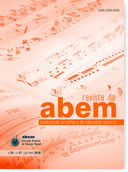Big Ideas in music teaching and learning: implications for cognitive research and practice
Resumo
This paper offers seven Big Ideas about music teaching and learning that might beconsidered in the coming years. They are offered in the spirit of reform for teachingmusic and include notions based on a constructivist-centered approach that favorsstudent voice in creating music, integrating work with other disciplines, and improvingassessment. The paper challenges teachers to consider who, what and where weteach music.
Downloads
Referências
GLADWELL, M. The tipping point: How little things can make a big difference. Little, Brown and Company,
GREEN, L. How popular musicians learn: A way ahead for music education. Ashgate Publishing, Ltd., 2002.
KRATUS, J. Centennial series: Music education at the tipping point. Music Educators Journal, v. 94, n. 2, p.
-48, 2007.
MARTINEZ, M. Big Ideas for Education. Phi Delta Kappan, v. 92, n. 6, p. 74-75, 2011.
SARATH, E.; MYERS, D.; CAMPBELL, P. Redefining music studies in an age of change: Creativity, diversity,
integration. New York: Routledge, 2016.
WEBSTER, P. Creative thinking in music: Advancing a model. In: SULLIVAN, T.; WILLINGHAM, L. (Eds.).
Creativity and music education. Edmonton, AB: Canadian Music Educators’ Association, 2002. p. 16-33.
WEBSTER, P. Constructivism and music learning. In: COLWELL, R.; WEBSTER, P. (Eds.). MENC Handbook
of research on music learning. V. 1. New York, NY: Oxford University Press, 2011. p. 35-83.
WEBSTER, P. There is nothing complex about a correlation coefficient. In: WELCH, G.; McPHERSON, G.
(Eds). Oxford Handbook of music education. Vol. II. New York, New York: Oxford University Press, 2012. p.
-697.
WEBSTER, P. Music composition intelligence and creative thinking in music. In: KASCHUB, M.; SMITH,
J. (Eds.). Composing our future: Preparing music educators to teach composition. New York, NY: Oxford
University Press, 2013. p. 19-32.
WEBSTER, P. Computer-based technology. In: McPHERSON, G. (Ed.). The child as musician. 2. ed. New
York, NY: Oxford University Press, 2016. p. 500-519.
WEBSTER, P. Developing tests of musical creativity. Chapter in Oxford Handbook of assessment policy and
practice in music education (edited by Timothy Brophy) (forthcoming).
WILLIAMS, B.; WEBSTER. P. Experiencing music technology. New York: Cengage/Schirmer, 2008.
WILLIAMS, D. B. The non-traditional music student in secondary schools of the United States: Engaging
non-participant students in creative music activities through technology. Journal of Music, Technology &
Education, v. 4, n. 2-3, p. 131-147, 2012.
Downloads
Publicado
Como Citar
Edição
Seção
Licença
Os(As) autores(as) que tiver(em) seu texto manuscrito aprovado deverá(ão) enviar à Editoria da REVISTA uma Carta de Cessão (modelo enviado no ato do aceite), cedendo os direitos autorais para publicação, em regime de exclusividade e originalidade do texto, pelo período de 2 (dois) anos, contados a partir da data de publicação da REVISTA.
DECLARAÇÃO DE ORIGINALIDADE E EXCLUSIVIDADE DE CESSÃO DE DIREITOS AUTORAIS
Declaramos que os artigos presentes na REVISTA DA ABEM são originais e não foram submetidos à publicação em qualquer outro periódico nacional ou internacional, quer seja em parte ou na íntegra. Declaramos, ainda, que, após um artigo ser publicado pela REVISTA DA ABEM, ele não poderá ser submetido a outra forma de publicação, no prazo de dois anos. Passado esse período, a REVISTA DA ABEM cede direitos aos(às) autores(as) para publicarem o texto em livros ou outro periódico, desde que haja autorização do Conselho Editorial.
Também temos ciência que a submissão dos originais à REVISTA DA ABEM implica transferência dos direitos autorais da publicação digital e, a não observância desse compromisso submeterá o(a) infrator(a) a sanções e penas previstas na Lei de Proteção dos Direitos Autorais (nº 9610, de 19/02/98).


